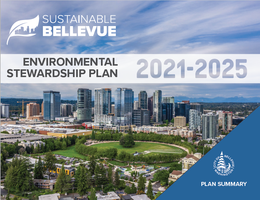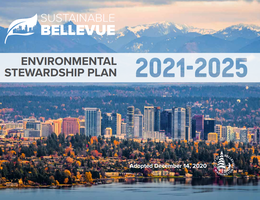Bellevue's Environmental Stewardship Plan is a strategic roadmap that lays out goals, strategies and targets that commit the city to act boldly and aggressively to ensure Bellevue is a healthy, livable, sustainable and prosperous “city in a park” for decades to come. The current 2021-25 Sustainable Bellevue plan was adopted in late 2020. The city is now in the process of developing a 2026-2030 update.
2026-2030 Update
The Environmental Stewardship Initiative team launched our 2026-2030 Sustainable Bellevue Plan update with the City Council on Oct. 29, 2024. Guided by our new greenhouse gas emissions reduction target of 95% by 2050 in the Comprehensive Plan, the city will focus on updating the Sustainable Bellevue’s strategies and actions to meet our 2030 goals and beyond.
Sustainable Bellevue Plan Update Engagement Opportunities
Thank you to all who participated in engagement opportunities so far. Please read our Phase I Engagement Report to learn about what we've heard so far, and stay tuned for more engagement coming this spring, starting with EarthFest on April 19! Please follow our project on Engaging Bellevue and subscribe to our newsletter to ensure you don't miss an update.
2021-2025 Plan History
On Dec. 14, 2020, the City Council adopted the 2021-2025 Sustainable Bellevue plan. Built on our past environmental stewardship successes and the expertise and input of more than 1,000 residents, city staff, community leaders and stakeholders, the plan has five focus areas:
- Climate change
- Energy
- Materials and waste management
- Mobility and land use
- Natural systems
Sustainable Bellevue's high-level goals include reducing communitywide greenhouse gas emissions by 50% by 2030 and 80% by 2050; reducing citywide drive-alone rates to 45% by 2050; achieving an overall tree canopy cover of 40%; and operating on 100% renewable energy by 2050, with a 30% reduction in overall energy use.
To help the city achieve these goals and targets, the plan lists 78 different actions across the five focus areas. The plan will be updated every five years through 2050 to ensure we're acting boldly and staying on track in creating a sustainable future in Bellevue for generations to come.
2021-2025 Plan Development
The tabs below contain details about the 2021-2025 plan development process and the full goals and targets.
Goals and Targets
Goals and Targets
After an initial phase of public engagement, best practices research and analysis, staff compiled a set of recommendations for the overarching goals and targets for the updated Environmental Stewardship Plan and presented them to the City Council on Nov. 12. The council expressed support for the following draft communitywide goals and targets for the plan:
Climate Change
Goal: Reduce Bellevue’s greenhouse gas emissions and prepare and adapt to ongoing climate change impacts.
- Reduce greenhouse gas emissions 95% by 2050, below a 2011 baseline.*
*Note: This updated greenhouse gas emissions reduction target was adopted as part of the new Comprehensive Plan. The previous target set by the 2021-2030 plan was 80% reduction.
Energy
Goal: Ensure long-term access to clean energy while reducing the fiscal and environmental impacts of consumption.
- Achieve 100% renewable energy by 2045.
- Reduce energy use by 30% by 2050, compared to a 2011 baseline.
Waste
Goal: Reduce the negative impacts from consumption and waste practices and strive towards zero waste of resources.
- Achieve zero waste by 2050.
Mobility and Land Use
Goal: Minimize the environmental impacts of transportation and development in Bellevue by focusing development in growth centers and providing all residents with access to a variety of mobility options.
- Achieve a 45% commute-trip drive-alone rate for residents and people working in Bellevue by 2050.
- Strive to have 50% electric vehicles registered in Bellevue by 2050.
- Reduce per capita vehicle miles travelled (VMT) by 50% by 2050, compared to a 2011 baseline.
- Support transit oriented development and strive to achieve 85% of jobs and 65% of households located with a ¼ mile of frequent transit service (every 15 minutes) by 2050.
Natural Systems
Goal: Improve and preserve the integrity and health of Bellevue’s natural systems and ensure all of Bellevue’s residents have access to Bellevue’s abundant natural resources.
- Achieve a 40% citywide tree canopy by 2050.
- Ensure that 100% of Bellevue’s residents live within 1/3 of a mile to a park, open space, or trail by 2050.
- Maintain and improve the health of Bellevue’s streams.
For more information on the recommendations and what we heard from the first phase of outreach, refer to:
2021-2025 Plan Outreach and Engagement
Phase 3 Outreach: Draft Plan
- Phase 3 Outreach Summary
- Draft Environmental Stewardship Plan for public comment
- Draft Environmental Stewardship Plan Summary
- We received over 100 responses to our draft plan survey along with dozens of comments, and are working are summarizing into a Phase 3 Outreach Summary, which will be shared soon.
- October 1 Draft Environmental Stewardship Plan Online Town Hall presentation
Phase 2 Outreach Summary: Support for Potential Actions
Staff conducted a second round of public engagement in the spring of 2020, to gather input and feedback on potential actions, and gauge the level of support for strategies for the plan. Outreach strategies included an open house, online survey with over 600 responses, focus groups, and an online townhall.
- Phase 2 Outreach Summary
- March 3 Open House Presentation Boards
- April 23 Climate Change Online Townhall presentation
Phase 1 Outreach Summary: How ambitious should we be?
Bellevue staff conducted an initial round of public engagement in the fall of 2019 with a community workshop, online survey, pop-up events, and a sustainability leaders focus group. We heard from over 400 people through these various engagement approaches.
- Phase 1 Outreach Summary: A summary of what we heard and the key themes and priorities from our outreach.
- Community Workshop presentation: On October 1st, the City hosted the first Community Workshop for the update to the Environmental Stewardship Plan.
Online Engagement
Check out Bellevue's new outreach and engagement hub, EngagingBellevue.com, where you can learn about upcoming events, take surveys, sign up to stay in the loop, and learn about other projects in Bellevue.
Council Updates
The presentation materials, agenda, minutes, and videos from previous Council presentations on the Environmental Stewardship Plan can be found below:
- December 14, 2020: Council adoption of the Sustainable Bellevue: Environmental Stewardship Plan
- November 16, 2020: City Council Study Session, Review of Recommended Environmental Stewardship Plan
- September 14, 2020: Update on Environmental Stewardship Plan progress and review of updated K4C Joint Commitments
- April 27, 2020: Update on progress - Cancelled due to Stay Home, Stay Healthy Order limitations on public meetings
- November 12, 2019: Environmental Stewardship Plan Updated: Recommended Goals and Targets
- May 20, 2019: ESI Strategic Plan Update Goals and Targets
- February 19, 2019: ESI Progress Report
- November 13, 2018: ESI Strategic Plan Update Proposed Workplan
Boards and Commissions
Council directed staff to engage with boards and commissions on the potential strategies and actions relevant to their purview. A summary of the engagement with the boards and commissions is provided in the Draft Plan Phase 3 Outreach Summary. The agendas, presentation, and minutes for each board and commission presentation can be found below.
Completed presentations
Phase 2 Engagement:
- East Bellevue Community Council, November 10, 6:30 PM
Human Services Commission, 10/20/2020; 6:00 PM - Youthlink Board, 10/14/2020; 6:00 PM
- Parks & Community Services Board, 9/10/2020; 6:00 PM
- Environmental Services Commission, 8/20/2020; 6:30 PM
- Arts Commission, 8/4/2020 4:30 PM; Agenda Materials
- Planning Commission, Wednesday July 22, 6:30 PM; Agenda Materials
- Transportation Commission, Thursday June 25, 6:30 PM; Agenda Materials
Phase 1 Engagement:
- Parks and Community Services Board: 1/14/2020 Cancelled due to weather: Agenda.
- Environmental Services Commission, 1/16/2020: Agenda and Minutes
- Transportation Commission, 1/23/2020 Agenda and Minutes.
- Planning Commission, 2/26/2020: Planning Commission Agendas.
2013-2018 Plan
The 2013-2018 Strategic Plan was created by an interdepartmental team of staff with consultation from Cascadia Consulting. The plan addressed both municipal and communitywide sustainability. It focused on five distinct areas:
- greenhouse gas emissions
- mobility and land use
- energy and water
- materials and waste management
- ecosystems and open spaces
There were 57 actions distributed among these five areas, along with 17 Key Performance Indicators to measure impact.
The benefits of these actions go beyond environmental stewardship. Enhancing parks and open spaces improves health outcomes while providing places to play, while reducing drive-alone rates decreases congestion. The ESI Plan Update seeks to expand upon these co-benefits of environmental action.
One notable success of the previous plan was Bellevue being awarded a four-star certification through the STAR Communities Rating System. This system evaluates strengths and weaknesses in seven areas and builds on a decade of environmental leadership on the part of the ESI. The report is available.
Progress Report
On February 19, 2019 a full report on the progress of the implementation of the 2013-2018 Environmental Stewardship Strategic Plan was presented to Council. This report assesses each of the 57 actions included in the plan, of which 34 were implemented and 21 were initiated, and two were not started.
The progress report outlines successes, such as purchasing green power from Puget Sound Energy, as well as areas to improve upon in the updated plan, such as waste diversion. This progress report helped to identify next steps and new actions for the 2021-2025 Environmental Stewardship Plan.
For up to date information on progress, check out the Environmental Stewardship Performance Dashboard.


